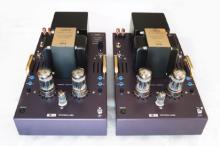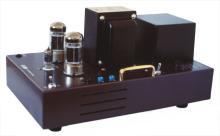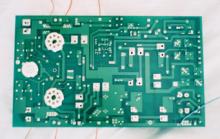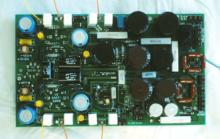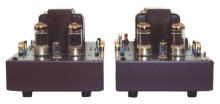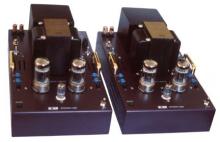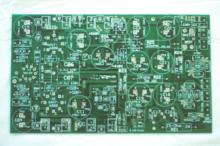Monoblock amplifiers
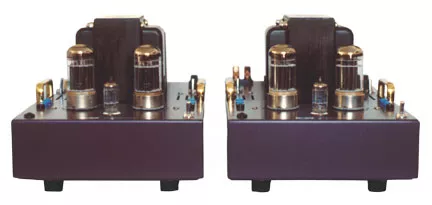
Circuit Description
All stages operate in pure class A1 single ended and contain automatic self-biasing circuitry. We have maintained our Topaz tradition in the use of exceptionally large value Solen polypropylene coupling capacitors. This together with our custom built Hammond output transformer has endowed this amplifier with very extended low frequency response. Each of the four output triodes are individually self-biased, with only the plates tied together in a quasi-parallel configuration, which is nearly equivalent to having one high-powered triode. Our 11 pound output transformer provides 13 Watts RMS per mono-block with solid bass and absolute stability into all low impedance loads. The output windings can be toggled via two high current switches to allow selection of impedance for 2, 4, 8 or 12 Ohms. We employ no feedback of any kind due to the low distortion ultra-linear amplification stages employed in this design.
Power Supplies
- Toroidal power transformer voltage input can be selected for 115V/230V 50-60 Hz operation via an internal toggle switch. Three output windings provide full-wave rectification using spike & noise suppression circuitry.
- Separate DC power supplies provide total isolation between the INPUT and output stages. These consist of a triple p (pi) filter for the 300 Volt output rail and a double p (pi) filter for the 450 Volt input & driver rail. The use of RC filter networks with very large electrolytic capacitors and wire wound ceramic resistors provide an unparalleled ripple reduction that is too low to be seen on our oscilloscope.
- Rectified and filtered DC provides the power for the input tube filament of the 1st and 2nd stage. The other two output tube filaments are provided with AC connected in a balanced configuration to eliminate any possibility of hum induced distortions. This provides a very low noise floor that allows all subtle nuances in the music to be heard.
Mechanical Construction
- Extremely rugged (14 gauge) all welded steel chassis was implemented to further reduce any possibility of vibration induced signal aberrations.
- Highly polished brass handles allow for easy handling and accentuate the chassis styling.
- Very high quality paint with primer coat and baked on finish to further enhance the artistry.
- A deep lavender colour accentuates the satin black finish of the output transformer and toroid cover.
- A cast aluminium box is used to cover the power Toroid transformer to strengthen an already appealing look.
Circuit Board
The components are mounted on a printed circuit board (PCB) which is made from FR4 glass epoxy with double sided copper traces and plated through holes. Both sides have a protective green solder mask. A silkscreen is printed in white showing the component layout and parts value. This PCB was designed manually in house. It has enlarged power and signal line traces to attain the best analog integrity that automatic routing circuit programs cannot attain. Our Printed Circuit Board program allows for an infinite varieties of traces and component layouts that can be developed into our own custom library parts. We have created a library of custom component layouts that are specifically suited to develop our Analog circuits. Wiring to the PCB is attached via screw down crimp terminals to allow for ease of repair should the need ever occur where the board would need to be removed. Again, like in the Topaz we have reduced the signal path length to less than 6" on the PCB board. The final assembly of parts to the PCB is done by hand soldering of all components, which is superior to automated flow-soldering techniques, by allowing more solder on each and every joint.
Auto-Sequencing
A time-delay relay provides extended tube life and proper power sequencing for stabilized circuitry on power up. The filament voltage is turned on for 45 seconds before applying the DC voltage power.
Power Switch
A toggle switch enables power to the automatic sequencing circuit that delays operation until the green ready LED comes on after the initial 45-second delay.
Impedance Matching
Two high current (25 Amp) toggle switches enable setting for 2, 4, 8 & 12 ohms
(matching numbers indicate which impedance is selected)
Specifications
Tube Complement
- Input / Driver Stage: dual triode 9-PIN base 5814A JAN Military NOS (or 12AU7)
- Output Stage: dual triode octal base 6AS7GA [JAN Military NOS] - can also substitute 6080WC
Frequency Response
+0/-1 dB > 9Hz to 22KHz
+0/-3 dB > 6 Hz to 38 KHz
Input Impedance
60 kOhms
Gain
29 dB > 0.35VRMS maximum for full output
Absolute Phase
non-inverting
Power Output
13 Watts RMS per Channel
Dynamic Headroom
music peaks up to 26 Watts
Power Supply Storage
280 joules
Universal Voltage Select
115/230 Volts 50/60 Hz
Power Consumption
125 Watts each
Weight
Net: 2 x 31 lbs. (28.2 kg)
Shipping: 2 x 36 lbs. (33 kg)
Dimensions
9.5" W x 16" L x 8.5" H
24.13 cm W x 40.64 cm L x 21.59 cm H
Reviews
Positive Feedback
21 - September/October 2005 - Reviewed by Francisco Duran
The Onyx monoblocks are capable of high resolution and impressive dynamics. They sound like solid-state amplifiers with tube virtues. They are fast and detailed, yet they display dimensionality and beautiful harmonics. If you get to chance to listen to them, you might feel as lucky as I did.
SoundStage!
September 2001 - Reviewed by John Potis
No matter what I threw at the Onyx amplifiers, they almost always sounded robust and in total control.
The Wyetech Onyx amplifiers do not exhibit any euphonic colorations classically attributed to tubes and at the same time possess some of the more positive attributes of the best solid-state amplifiers that I’ve heard.
Secrets of Home Theater and High Fidelity
December 2004 - Reviewed by Jason Victor Serinus
Whether I was listening to string quartets or piano sonatas, there was a specialness to the midrange too rarely experienced from high-end amplifiers.
There is an uncommon feathery delicacy to the Onyx’s midrange and upper bass that makes for a special listening experience. Mated with speakers of sufficient efficiency, the Onyx monoblocks are sure to win new converts to the world of single-ended triode amplification.
The Absolute Sound
Issue 132 (October/November 2001) - Reviewed by Dan Davis
…defies expectations.
… exhibits far more muscle than others of its breed...
The Inner Ear Report
Volume 13, # 4 (2001) - Reviewed by Ernie Fisher
The amplifiers dynamics are not good, not even very good, they are excellent.
Warranty
Limited Warranty
Tubes: 1 year parts
Components 5 years parts & labor
